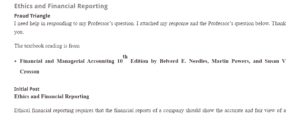Fraud Triangle
In his article, “Why Do Trusted People Commit Fraud?” Cressey (1951) contends that the fraud process can be categorized into three stages. They are motivation, opportunity, and rationalization. Motivation is the pressure on an individual to acquire additional finances (Schuchter & Levi, 2016). This pressure may drive an employee to acquire finances illegally and unorthodoxly. The need for money may arise from various circumstances. For instance, the fraudster may have a sick relative and possess an extravagant habit such as gambling. In other cases, the employee may perceive underpayment as opposed to other workers or the workload, motivating him to steal from his employer. The second step, dubbed opportunity, entails the identification of instances when the employee can unsuspectedly take the money. The culprit identifies opportunities that they perceive are most suitable and exhibit less likelihood of being caught. For instance, when the cash drawer is left unlocked at night — or forging the employer’s cheque.
Are you seeking an initial copy of “Fraud Triangle”? Reach out to us.
The last stage, rationalization, pertains to the offender’s justification for his actions. This stage entails defense by the fraudster for his fraudulent actions. For instance, he may state that he took money from the cash drawer as a way of borrowing and would return it later. Also, he may state that the employer underpays him, so the robbery was to compensate him. In Beacon’s case, the fraudulent actions by the management were inspired by greed as they sought to earn additional bonuses. They used the opportunity of misstating the revenue collected from the $ 7 million project to indicate higher net earnings in the financial statements. They might justify their actions as seeking fair compensation; the project would be completed quickly.
Other Related Post: Chapter 3 Questions
References
Schuchter, A., & Levi, M. (2016). The Fraud Triangle Revisited. Security Journal, 29(2), 107-121.
Cressey, D. R. (1986). Why Managers Commit Fraud. Australian & New Zealand Journal Of Criminology, 19(4), 195-209.
ORDER A PLAGIARISM-FREE PAPER HERE
We’ll write everything from scratch
Question
Ethics and Financial Reporting
Fraud Triangle
I need help in responding to my Professor’s question. I attached my Response and the Professor’s question below. Thank you.

Fraud Triangle
The textbook reading is from
- Financial and Managerial Accounting 10th Edition by Belverd E. Needles, Martin Powers, and Susan V Crosson
Initial Post
Ethics and Financial Reporting
Ethical financial reporting requires that a company’s financial reports show an accurate and fair view of a firm’s financial position and statements of affairs (Melé, 2017). Usually, a company’s management is responsible for preparing the financial reports and, therefore, accountable for any misstatement or unfair information provided. Financial statement users have a right to reliable information recorded in the income statements (Frias‐Aceituno, 2014). Therefore, generally accepted accounting principles (GAAP) specify recognition, valuation, and classification as significant factors in ethical financial reporting; these factors enable the management to produce reliable information for the company’s shareholders and creditors.
The management of Beacon System has not acted ethically since they intend to violate the recognition guideline. The company recognizes revenue based on the percentage of completion. The company’s management has requested a new report showing 90% completion, yet the $7 million project is only 75% complete; the change will enable the senior managers to achieve their financial goals for the year, thus receiving a bonus at the year-end. If the amendments are made, the revenue generated from the project for the period will be overstated, and so the net earnings. It means that the financial report for the year-end will not be reliable for the shareholders and other users of the report.
If asked to prepare a new report showing 90% completion, I would not develop the report because the change doesn’t reflect the revenue generated. The latest release is based on self-interest since senior managers only try to secure a substantial year-end bonus. Upon receiving the request, I will write to the management explaining that the report intends to deceive shareholders and other users of the report (Hope, 2013). If the administration disagrees, I will contact the firm’s directors concerning the reporting issue and the disagreement with the management.
God Bless
References
Frias‐Aceituno, J. V.‐A.‐S. (2014). Explanatory factors of integrated sustainability and financial reporting. Business strategy and the environment, 23(1), 56-72.
Hope, O. K. (2013). Financial reporting quality of US private and public firms. The Accounting Review, 88(5), 1715-1742.
Melé, D. R. (2017). Ethics in finance and accounting: Editorial introduction. Journal of Business Ethics, 140(4), 609-613.
Professor’s Response and Question
Great post!
Thank you for sharing information about ethics. Your comments were clear and concise. Explain and provide examples of the Rationalization component of the Fraud Triangle.
Regards,
Professor


